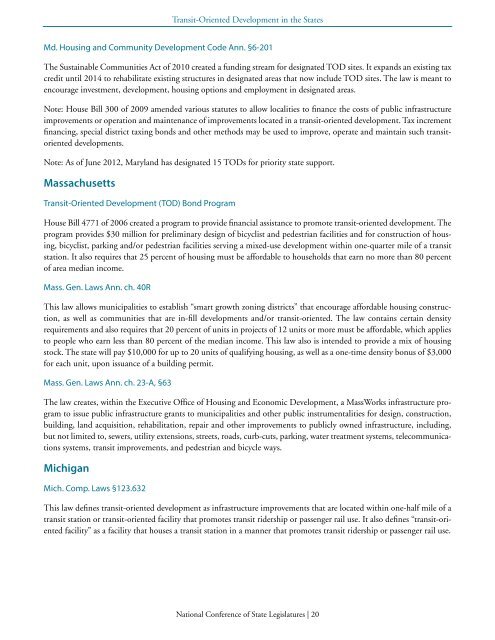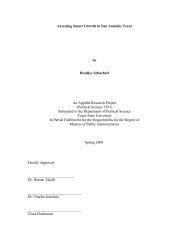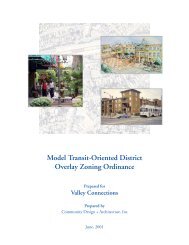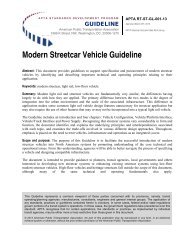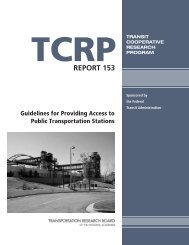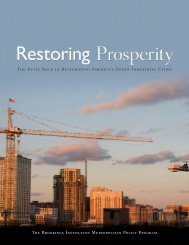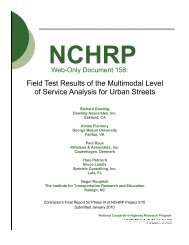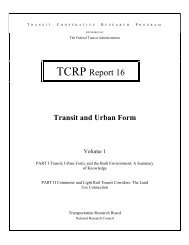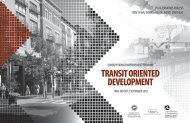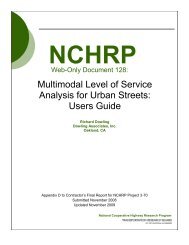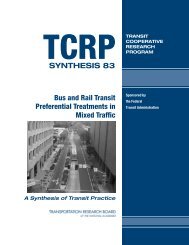Download the full report (PDF, 734 KB) - Reconnecting America
Download the full report (PDF, 734 KB) - Reconnecting America
Download the full report (PDF, 734 KB) - Reconnecting America
- No tags were found...
Create successful ePaper yourself
Turn your PDF publications into a flip-book with our unique Google optimized e-Paper software.
Transit-Oriented Development in <strong>the</strong> StatesMd. Housing and Community Development Code Ann. §6-201The Sustainable Communities Act of 2010 created a funding stream for designated TOD sites. It expands an existing taxcredit until 2014 to rehabilitate existing structures in designated areas that now include TOD sites. The law is meant toencourage investment, development, housing options and employment in designated areas.Note: House Bill 300 of 2009 amended various statutes to allow localities to finance <strong>the</strong> costs of public infrastructureimprovements or operation and maintenance of improvements located in a transit-oriented development. Tax incrementfinancing, special district taxing bonds and o<strong>the</strong>r methods may be used to improve, operate and maintain such transitorienteddevelopments.Note: As of June 2012, Maryland has designated 15 TODs for priority state support.MassachusettsTransit-Oriented Development (TOD) Bond ProgramHouse Bill 4771 of 2006 created a program to provide financial assistance to promote transit-oriented development. Theprogram provides $30 million for preliminary design of bicyclist and pedestrian facilities and for construction of housing,bicyclist, parking and/or pedestrian facilities serving a mixed-use development within one-quarter mile of a transitstation. It also requires that 25 percent of housing must be affordable to households that earn no more than 80 percentof area median income.Mass. Gen. Laws Ann. ch. 40RThis law allows municipalities to establish “smart growth zoning districts” that encourage affordable housing construction,as well as communities that are in-fill developments and/or transit-oriented. The law contains certain densityrequirements and also requires that 20 percent of units in projects of 12 units or more must be affordable, which appliesto people who earn less than 80 percent of <strong>the</strong> median income. This law also is intended to provide a mix of housingstock. The state will pay $10,000 for up to 20 units of qualifying housing, as well as a one-time density bonus of $3,000for each unit, upon issuance of a building permit.Mass. Gen. Laws Ann. ch. 23-A, §63The law creates, within <strong>the</strong> Executive Office of Housing and Economic Development, a MassWorks infrastructure programto issue public infrastructure grants to municipalities and o<strong>the</strong>r public instrumentalities for design, construction,building, land acquisition, rehabilitation, repair and o<strong>the</strong>r improvements to publicly owned infrastructure, including,but not limited to, sewers, utility extensions, streets, roads, curb-cuts, parking, water treatment systems, telecommunicationssystems, transit improvements, and pedestrian and bicycle ways.MichiganMich. Comp. Laws §123.632This law defines transit-oriented development as infrastructure improvements that are located within one-half mile of atransit station or transit-oriented facility that promotes transit ridership or passenger rail use. It also defines “transit-orientedfacility” as a facility that houses a transit station in a manner that promotes transit ridership or passenger rail use.National Conference of State Legislatures | 20


